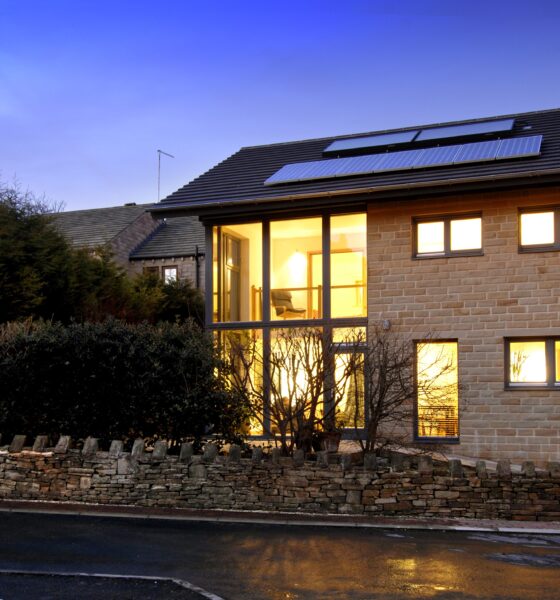

Economy
Passivhaus: maximising comfort while minimising energy
In the late 80s, two building researchers – Bo Adamson of Lund University, Sweden and Wolfgang Feist of Institute for Housing and the Environment, Germany – came up with an idea to maximise the comfort of homes while dramatically reducing their energy usage. The result was the Passivhaus standard, by which over 25,000 properties around the world are now certified .
In the UK, the Passivhaus standard has been promoted and protected by the Passivhaus Trust since 2010. It’s a very new concept, with around 200 complete and certified passive houses currently.
But with over 500 Passivhaus-certified buildings in the pipeline, within two years there is set to be over 1,000 homes with the accreditation.
The Passivhaus Trust’s chief executive Jon Bootland tells Blue & Green Tomorrow more.
This article originally appeared in Blue & Green Tomorrow’s Guide to Sustainable Homes 2013.
Why do we need the Passivhaus standard?
There are consistent problems in the performance of new homes around their energy use, ventilation and potential overheating risks, and therefore the wellbeing of the occupants. Passivhaus, as a low-energy and comfort standard, gives you a software tool and a standard to come up with a solution that addresses all of those things and resolves them all for you.
The Passivhaus Trust promotes the standard in the UK, ensures its integrity, and makes sure that when Passivhaus buildings are built to that standard, they do what they say. It’s a very high quality standard that has a lot of rigour in its approach.
What is a passive house?
It’s a very low-energy building that provides optimal occupant comfort conditions, adjusted for the local environment.
More specifically, it’s a building that can meet all of its heating energy requirements, simply by heating small amounts of ventilation air coming into the building. You need very little heating.
Is the definition of a sustainable home different?
Passivhaus is an energy and comfort standard only. That’s all it does. It does that very well, and very few other people can do that at the minute.
A sustainable home must address lots of other things as well, such as the kind of materials that you use in the home, or whether you’ve got green space nearby, or whether you’re sited near public transport links or local amenities. Passivhaus doesn’t address any of those; it just sorts out very well the energy and comfort parts.
Is the Passivhaus standard for new homes only?
No, there is a Passivhaus standard for retrofit as well. It’s a very exacting standard, so it’s not something to be undertaken lightly. And it is slightly less demanding than the new-build standard, because it needs to take into account things that you can’t change, like the orientation of the building, which affects how much sunlight you’ll gain during winter months for example.
You can’t change that when your house is already built, so we have to make an allowance for that on existing homes. It’s also very difficult to insulate underneath the floor in an existing building, so the standard is relaxed slightly for a refurbishment project, but it is still very demanding.
Can the Passivhaus standard become mainstream?
I’m not sure it’s going to be a product for the mass market house builders for a few years. That’s because the main benefit is in the running costs, which benefit the occupier, not the builder! Heating bills might be £100-£200 per year for a Passivhaus, compared to £1,200-£1,500 a year for a typical home. That’s an enormous difference.
If you’re a private buyer and this is going to be your house for life, and you’re going to be retiring into this house and owning it for 20 years, saving £1,500 a year on your heating bill makes a lot of sense. You’ll have a much higher quality home, it should retain its value better and it should be easier to maintain, so it’s worth paying a little bit extra in order to have that saving.
But if you’re a major house builder and you’re just going to sell the houses and then leave, the savings will accrue to the person who buys the house and lives there – not the person who built it.
What do you see of the future of sustainable homes?
The government is very keen to water down and relax standards at the minute. The Housing Standards Review is underway at the minute and it seems likely that the Code for Sustainable Homes might be axed, for example. So in broad sustainability terms, I think the immediate future looks a little bit bleak.
But for low-energy homes, I think it’s a different matter. The government is still committed to improving the standards of new homes towards the Passivhaus level and Passivhaus is still above what current regulations require.
Buyers and homeowners are also starting to get switched onto it. There was some research last year that showed people expect an energy efficient home to hold its value better and to be worth more in the long-term, so I think homeowners will start to recognise the value of having a very low-energy and energy efficient home. I think that will start to drive the market on the energy efficiency front.
In addition, as well as being a good investment for individual, high-end homeowners, I think that Passivhaus also makes a lot of sense for housing associations whose tenants are in fuel poverty to have very low fuel bills. So the future for Passivhaus could be bright indeed.
Jon Bootland is chief executive of the Passivhaus Trust.
Further reading:
Making your period home more energy efficient: a practical guide
Mythbusting on sustainable homes
































